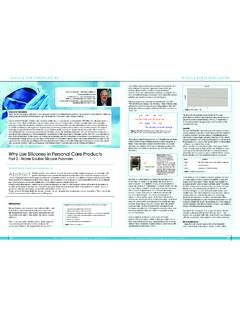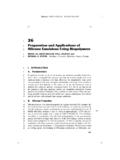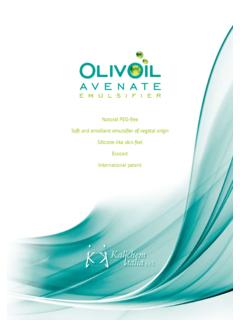Transcription of PEG/PPG dimethicone structure and function
1 April dimethiconestructure and functionPEG/PPG dimethicone compounds shouldbe used in instances where they providebenefits that cannot be obtained by organiccompounds. These properties include: Lowering of surface tension (into therange of 25 dynes/cm). Provide unique skin feel. Provide unique emulsification properties(especially in invert emulsions). Provide film formation. Provide foaming of properties are a direct result of thestructure, but the structure needs to becarefully selected. PEG/PPG dimethiconepolymers have increased polarity, by virtueof their polyoxyalkylene groups. It isimportant to note that these modificationsare done by chemical reaction between a reactive silicone and a vinyl containingcompound. A very common structure isshown in Figure 1. There are several variables that can bemodified to change the performance of thePEG/PPG polymer. One of the mostimportant is the ratio of a (silicone solubleportion) to b (water soluble portion) as wellas the total number of a and b, both ofwhich are important to functionality.
2 Thehigher the ratio of a to b the less watersoluble the product. Also, the molecularweight of the PEG/PPG polymer candrastically change properties. The studiespresented in this paper keep the ratio ofD/D* constant (that is the ratio of a/b iskept constant relative to each other).Surface tensionWhen added into water at lowconcentrations, PEG/PPG dimethicone (DMC) migrates to the air/water more PEG/PPG is added into the water,the interface becomes saturated and acritical point is achieved. When additionalPEG/PPG polymer is added, it cannotmigrate to the interface, so they start toform micelles. This critical point where theinterface is saturated and micelles start toform is called the critical micelleconcentration (CMC). Critical micellePEG/PPG dimethiconestructure and functionFigure 2:Illustration of (-Si-O)a-(-Si-O)b-Si-CH3CH3CH3CH3CH3CH3C H3(CH2)3O-(CH2CH2O)x(CH2CH(CH3)O)y(CH2CH 2O)zHCH3 Figure 1:PEG/PPGdimethicone 3:Graphic surface tension and molecular the increasing usage of silicone polymers in personal care products, theselection of the proper polymer for a particular application remains somewhat directly results in inefficiency of formula development.
3 This problem is exacerbatedby the reliance upon INCI names in selection of compounds. While helpful in placingpolymers in a generic class, it is of limited help in optimising formulation that are water insoluble, water dispersible or water insoluble can all sharea common INCI name. Likewise polymers that provide wetting, emulsification, orconditioning can share a common INCI name. This article is intended to clarifyselection of products for 8 dimethicone ( solution)Table 1: Surface tensionand molecular 8 dimethicone ( wt% solution)ProductMolecular Surfaceweighttension(dynes/cm) tensionCMCC oncentrationSurface tension (dynes/cm)Molecular weight2726252423222120500100015002000250 02 PERSONAL CARER eprinted from April 2013 Tony O Lenick PhD Siltech LLC, US Thomas O Lenick PhD SurfaTech Corporation, USSILICONES concentrations are determined bymonitoring surface tension.
4 Figure 2 showsan illustration of what happens uponaddition of a surfactant into bulk surface tension starts to decreasein a linear relationship with the amount of surfactant added. The moment theinterface gets saturated, the surfacetension stops key to surface tension efficiency isthe ability of a polymer to migrate to theinterface and take up the maximum freevolume on that interface. This maximisationof free volume at the interface and itsaffinity for the interface makes thePEG/PPG extremely effective at loweringsurface tension. This leads to PEG/PPGbeing used at very low concentrations todrastically change the properties of asolution. The molecular weight is a keyconcept in determining CMC. As themolecular weight increases, the CMCdecreases. This is due in part to the factthat the surface can accommodate fewer large molecules than small CMC of a PEG/PPG is a key property tobe determined before using a specificPEG/PPG in formulation, this is based uponthe observation that if the PEG/PPG cannotget to the interface, it will not providedesired properties to the formulation.
5 Aswill become clear subsequently, interactionwith other raw materials in the formulationneeds to be considered as surface tensions are related to the molecular weight of a series of PEG 8dimethicone in which the ratio of siliconeunits to polyoxyalkylene units (a:b) are kept constant but increases. The resultsare shown in Table 1 and Figure structure / function relationship isseen in these same compounds in bothwetting times and eye irritation as properties as afunction of molecular weightThe term wetting refers to how a materialcoats a surface. For example, if a waterdrop is placed onto a lotus leaf, the waterwill minimise the interaction with the leafand have a high contact angle. If a goodwetting agent is added either to the surfaceof the leaf or in the water solution thatsame drop will spread out coating thesurface of the leaf, in turn making the leaf wet , and this is where the term wettingcomes from.
6 Figure 4 illustrates theYoung s equation and how the contactangle is defined. Figure 5:Wetting time (seconds) versus molecular -(-S i-O)a-(-Si-O)b-Si-CH3CH3CH3(CH2)3CH3O-(C H2CH2O)18(CH2CH(CH3)O)18 HFigure 6:Sample F PEG 18/PPG 18dimethicone 4:Contact 2: function of dimethicone copolyol versus molecular weight (Da)Function500 Wetting2500 Emulsification10000 Conditioning50000 WaterproofingTable 3: Draves time (Seconds) 4: PEG 8 dimethicone 1% foam 3 minutesA6079062B8089063C11089567D1610906 2E21119061 Table 5: Foam 18/PPG 18 dimethicone 1% in 3 MinutesF76009750 Table 6: Surface tensionSampleMolecular Surface tensionweight(dynes/cm) s equation sv= sl+ lvcos is the contact angle svis the solid surface free energy slis the solid/liquid interfacialfree energy lvis the liquid surface free energy lv sv sl VapourLiquidSolidWetting time (seconds)Molecular weight3002502001501005000500100015002000 2500 SILICONESR eprinted from April 2013 PERSONAL CARE4patented (US Patent 7,951,893 toO Lenick et al, issued May 31, 2011).
7 This class of compounds, referred to asStar Silicones, have unique properties and are a model useful in explaining theproperties observed above. The structure ofPEG 8 dimethicone is shown in Figure structure of the Star compound(Sample G) evaluated is shown in Figure 8and a comparison of the properties ofSample E and G are shown in Table is noteworthy that the surface tensionof Sample G is more reminiscent of a fatty compound than of a silicone (30s dynes/cm not 20s dynes/cm). It isalso quite significant that the foam level The contact angle is defined as theangle the water makes with the surface. In this illustration, a low contact angle( <90 ) means the surface is contact angles ( >90 ) lead to asurface that is measure of wetting is the timerequired for a standard skein of fibre, or of hair to drop in an aqueous solution. This type of wetting time is called DravesWetting (ASTM D2281).
8 The lowermolecular weight PEG/PPG polymer hasfaster wetting times than their highmolecular weight counterparts. The lowermolecular weight polymers allow for moreefficient packing and dynamics. Thematerials with lower molecular weight wereextremely effective at the higherconcentration of w. Their wettingspeeds were almost instantaneousmeaning it is controlled by the diffusion ofthe PEG/PPG polymer to the air/waterinterface. The interesting finding is that thewetting speed is lost slowly as themolecular weight is increased. The slopeincreases once one gets to a molecularweight over 2000. This implies that a rapidwetting conditioner can be prepared byproper selection of molecular weight. Asthe molecular weight of a polymerincreases, its ability to function in differentcapacities changes. This is due to hydrogenbonding and achieving lowest free the ratio of a to b is held constant,the molecular weight of the polymerscontrols its wetting properties.
9 As shown inTable 3, as molecular weight increases, thewetting ability decreases. Table 3 shows intabular form the effect of molecular weighton wetting time and Figure 5 shows thesame data in graphic to generate foam is an importantfunctionality in any surfactant, includingsilicone surfactants. The ability to generatefoam results from the balance of siliconeportion to water soluble portion, whichincludes as an important variable theamount of PEG/PPG . The cylinder shakefoam test data is shown in Table data in Table 4 indicates thatchanges to the PEG-8 dimethicone with theD/D* ratio evaluated has really no effectupon foam, either initial or after 3 change was made to Sample E replacingthe PEG 8 group with PEG 18/ PPG material was designated Sample F and is shown in Figure 5 shows the result of the foamtesting on Sample F. Table 6 shows theresult of the surface tension testing onSample inclusion of more EO and POlowered foam, but interestingly also raisedthe surface tension.
10 Simply put, the highlyalkoxylatyed PEG/PPG polymer had asurface tension like a fatty alkoxylate, notlike a siliconesKnowing that molecular weight as shownabove has little effect upon foam propertieswhen the D/D* is kept constant, and thatinclusion of EO/PO did not improve foam, anew series of products has been made andCH3-Si-O-(-Si-O)a-(-Si-O)b-Si-CH3CH3C H3CH3CH3CH3CH3(CH2)3O-(CH2CH2O)8 HCH3 Figure 7:PEG 8dimethicone (CH2CH2O-(CH2)3-Si-O-(- Si-O)a-(-Si-O)b-2-Si-(CH2)3 O-(CH2CH2O)8 HCH3CH3CH3CH3CH3CH3(CH2)3O-(CH2CH2O)8 HCH3 Figure 8:PEG 8/Bis PEG 8dimethicone (Sample G).Table 7: Property ESample GStar ProductSurface ( aqueous)Foam height 90185(1% aqueous)Cloud point ( C)5889 Wetting time>200>200(seconds)Table 9: Eye irritation of PEG 8 dimethicone by molecular 8: Draize primary ocular irritation irritating CARER eprinted from April 2013 is more than twice the non-star significantly is the cloud point, thetemperature at which a 1% solution inwater of the product becomes hazy whileheating.)










